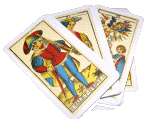
Bohemian Gothic Tarot
V THE HIEROPHANT
Lighter or more conventional meanings
Organisations and hierarchies * Sticking to socially-approved norms * A teacher or guru, in a formal setting * Following, or becoming, a leader, teacher or priest * The establishment * Rules, regulations and laws.Darker, shadow or more hidden meanings
A teacher who is dictatorial and fanatical * An institution that oppresses or attempts to control its membership * A cult * A system of beliefs that has become rigid * Learning that's so systematised that it stifles creativity.The Hierophant is sometimes seen as a problematic card in a reading. It stands for convention, social and political structures, formal training and education and, in general, everything to do with the establishment. In our freedom-loving times in which individual creative expression often takes precedence over following the rules and the "approved" way, we tend to see The Hierophant as symbolising something stifling and dull. However, this card potentially has very positive aspects: it might indicate success in a college or vocational course, or a good time to join an organisation or established group. It can indicate any form of well-structured or socially-recognised institution not necessarily just those that are conservative. The card can also signify a guru, teacher or guide who you are willing to follow and learn from. In this last case it's important to note that although generally The Hierophant always shows a man (in fact the card was derived from the earlier Tarot de Marseille Pope or Papus cards) it can equally be taken to signify a woman.
In the Bohemian Gothic version of this card though, the repressive and authoritarian aspects are brought to the fore. The scene feels enclosed and slightly oppressive. The Hierophant in this image is lost in contemplation. Seated, half slumped, with one finger on his forehead and the other holding a script or document he stares straight out as if questioning or confronting the viewer. He wears buttoned up robes and a tight red cape and appears altogether immobile, held down by his own clothing. Behind him a decorative statue is frozen in stone making an expansive, dramatic, though rather melancholy gesture - perhaps a symbol of the more flippant side of himself that this hierophant has pushed away. Looking further into the background we see a nun walking behind the gridded window behind the main figure. Is she, literally or metaphorically, trapped?
The figure on this card is based on a photograph of Sir Henry Irving (1838-1905) the eminent Victorian stage actor. His inclusion in the deck is particularly appropriate as Bram Stoker, author of Dracula, was Irving's assistant for many years. It's said that the character of Count Dracula himself may have been based on Irving.
Some further ways to consider this card
The Hierophant and The High Priestess are in quite different styles. The High Priestess is more mythic, whereas The Hierophant shows a realistic portrait of a Victorian grandee. How does this effect the way you read these two cards? When they appear together what can you find that's similar about them? What is dissimilar in their overall tone?The door was thrown open with violence. A figure entered, and drew near my bed with solemn measured steps. With trembling apprehension I examined this midnight visitor. God Almighty! It was the Bleeding Nun! It was my lost companion! Her face was still veiled, but she no longer held her lamp and dagger. She lifted up her veil slowly. What a sight presented itself to my startled eyes! I beheld before me an animated corpse. Her countenance was long and haggard; Her cheeks and lips were bloodless; The paleness of death was spread over her features, and her eyeballs fixed steadfastly upon me were lustreless and hollow.
- Matthew Lewis, The Monk.









